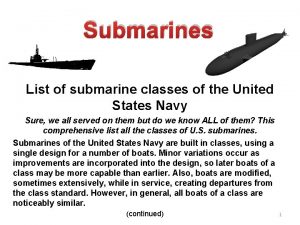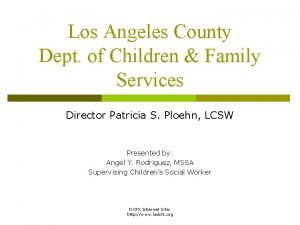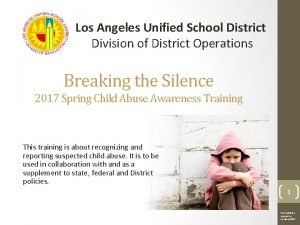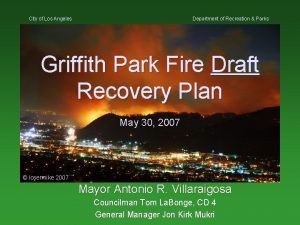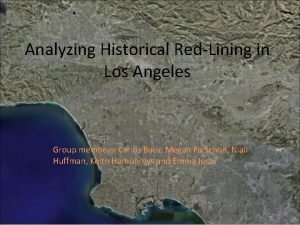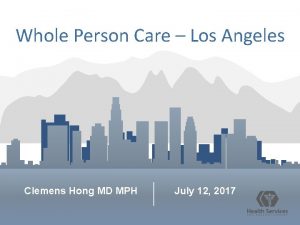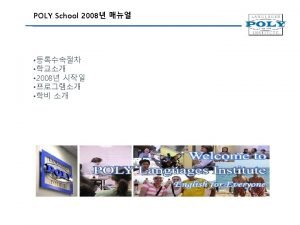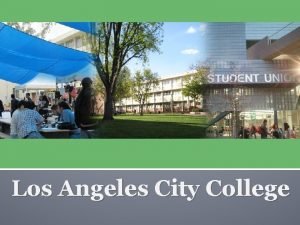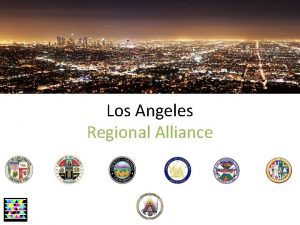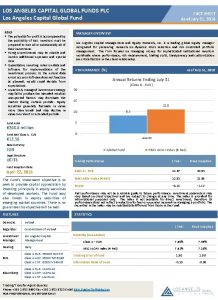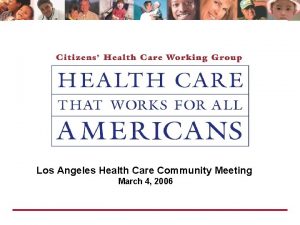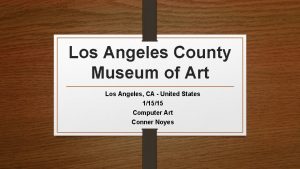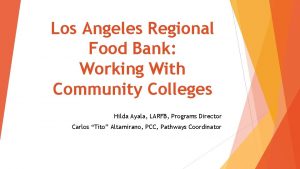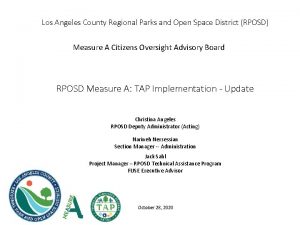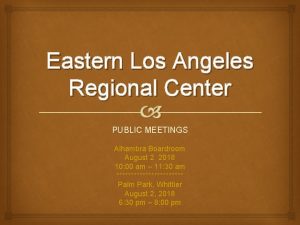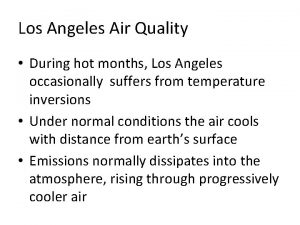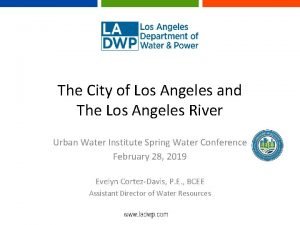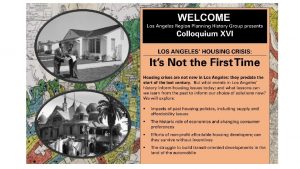Los Angeles Regional Alliance Los Angeles Regional Alliance
























- Slides: 24

Los Angeles Regional Alliance

Los Angeles Regional Alliance – The Alliance Concept • Ryan Rockabrand, Los Angeles County OEM/The Alliance – Mass Evacuation Overview • Sergeant Eric Fox, Los Angeles County Sheriff’s Department

A Whole Community Approach A Holistic Planning Methodology “We need to move away from the mindset that Federal and State governments are always in the lead, and build upon the strengths of our local communities and, more importantly, our citizens. We must treat individuals and communities as key assets rather than liabilities. ” - W. Craig Fugate, FEMA Administrator

Who is the Whole Community? … VOLUNTEER, FAITH, NON-PROFIT AND COMMUNITY-BASED ORGANIZATIONS, THE PRIVATE SECTOR, AND THE PUBLIC, INCLUDING SURVIVORS THEMSELVES Who is that to me? …

Combined Statistical Area • • • 5 counties 35, 000 square miles 18 million people Over 1 million tourists Over 150 countries & languages represented

My LA County Stakeholders

The Alliance • Multi-Jurisdiction • Multi-Agency • • • • All 5 Counties Police & Fire Emergency Managers Public Safety Officials First Responder Agencies Public Works Parks & Recreation Transportation (Public & Private) Volunteer Agencies Hospitals Schools and Colleges Utilities and Infrastructure Operators Private Sector Partner Stakeholders

Plan, Train, Exercise Organize and Staff - Develop plans to organize and staff catastrophic plans to ensure adequate support to review, develop, implement, and revise plans as needed. Train - Develop and implement plans to effectively train newly developed regional catastrophic plans with communities, States, nonprofit organizations, and the private sector, as well as other regional partners. Exercise - Develop and implement plans to exercise regional catastrophic plans to test capabilities and interdependencies between jurisdictions based on regional threats. Evaluate and Improve - Assess ability of plans to address regional catastrophic needs, evaluate findings, and develop corrective action plans to improve plans based on lessons learned.

What To Do • Support mechanism to member organizations • Address specific objectives defined by leadership, grant guidance and gaps identified in the Homeland Security Strategic Plan • Serve as the liaison between locals and the beltway • Empower stakeholders • Offer ‘White-label’ solutions

How To Operate/Sustain • Funding Mechanisms: – Grants – 501 c 3’s • NGOs • Foundations – COGs – Private Sector • Offer assistance via: – Fiscal year end spending – Match requirements

Governance • Regional Catastrophic Planning Team (RCPT) – Membership includes direct or indirect representation of all jurisdictions from CSA for regional planning – Coordinates the development & implementation of grant initiatives – Develops & maintains the Charter (working groups) – Cultivates sustainment strategies

VJPO / Lync

Federal, State, Local Integration

Alliance ICAD Missions • Information Collection, Analysis & Dissemination Teams – Domestic: Houston, Miami, Mississippi, Seattle, Atlanta, San Francisco, New Orleans, New York – International: Chile, Australia/New Zealand, Japan

Alliance Projects In Detail

Mass Care & Shelter Addresses Planning Processes for Mass Care Functions: • • Services: Sheltering, Feeding, Bulk Distribution, Basic First Aid, and Disaster Welfare Information Four Associated Annexes: Household Pet Sheltering, Medical and Health, Non-Traditional Sheltering, and Transportation Management

Reception Processing Guide Addresses Processes: • • • Types of Reception Sites: Pickup, Evacuation, Transfer, Info Points Reception Processing Sites vs Shelter Reception Area Critical Coordination Points: Decon, Medical Triage, FAC, LAC, VRC Concept of Operations, Planning Considerations & Strategies Reception Site Locations, Services, Scalability Operational Design Reception Logistics, Admin & Finance, Return & Re-Entry

Regional Recovery • Identifies planning principles when developing recovery plans, emphasizing consistency with the recently released National Disaster Recovery Framework • Identifies functional roles and responsibilities to manage recovery operations • Explains the relationships between Emergency Functions (EF) used during response and Recovery Support Functions (RSF) and the transition to recovery • Emphasizes a ‘Whole-of-Community’ approach to recovery planning and recommendations for incorporating community-based organizations and private-sector partnerships in the process • Provides detailed planning guidance for each of the six RSFs necessary for successful recovery following a catastrophic event: • • • Community Planning and Capacity Building RSF Economic RSF Health and Social RSF Housing Recovery RSF Infrastructure Systems RSF Natural and Cultural Resources RSF

Disaster Housing Working Group - Disaster awareness and preparation by the region’s housing industry; Includes private and public sector participants 1. Assessment & Gap Analysis Report Conduct an assessment and gap analysis of disaster housing preparations within the five county region 2. Short-Term/Interim Housing Options Report Create an inventory of all short-term housing options in the Region 3. Safety Assessment Module (SAM) Software Web application for conducting damage assessments 4. Disaster Housing Planning Guide for local jurisdictions which includes checklists of critical information needed for planning purposes and resources for information gathering 5. Legislative & Regulatory Resources Report Research legislative and regulatory resources to identify legal authorities that can facilitate or prevent pre and post-disaster residential recovery and reconstruction

Medical Points of Dispensing (M-PODs) Direct support of Federal Emergency Support Function #8 - Public Health and Medical Services • • Expand upon each jurisdiction’s capability to provide mass prophylaxis Each jurisdiction has developed and maintain site-specific POD plans by: • • • Conducting facility assessments Writing facility use plans, and Developing security and traffic management strategies To regionalize these plans, the working group and counties established a regional POD planning process and identified minimum plan components. Each member of the group included project colleagues in POD exercises and plan peer review.

Commodities Distribution (C-PODs) There are two major project components: 1) Develop a site-specific CD Plan for 20 independent sites (identified below), located in all five counties, using a prescribed CD Plan Template and guidelines. A site is defined as an open area that is paved, concrete, or gravel hard-stand, typically ranging from one to three acres (e. g. a large parking lot). 2) Identify and log commodity-based businesses in the five counties using the provided Business Database Template, and generate a map with that data in Arc. GIS. Number of Sites Per Jurisdiction for Site-Specific Planning Project • Los Angeles City - 5 • Los Angeles County - 6 (for areas excluding LA City) • Orange County - 3 • Riverside County - 2 • San Bernardino County - 2 • Ventura County – 2

Non-Traditional Sheltering

Mass Evacuation Guide Addresses Processes: • • • Rapid reference guide for Pre/Post-Incident Planning and Direction Evacuation Management Continuity of Operations/Government (COOP/COG) Access and Functional Needs Populations Communications Private and Non-Governmental Organization (NGO) Cooperation

Tag Us For More Information www. catastrophicplanning. org
 Aunque hablara la lengua de los angeles
Aunque hablara la lengua de los angeles Grayback submarine
Grayback submarine Rge 1
Rge 1 Lahc nursing
Lahc nursing Child welfare services
Child welfare services Rdox los angeles
Rdox los angeles Doctora roselyn valerin
Doctora roselyn valerin Upa tracking
Upa tracking Right side up agency
Right side up agency Los angeles schools
Los angeles schools Los angeles position
Los angeles position Los angeles schools
Los angeles schools Los angeles oesophagitis classification
Los angeles oesophagitis classification Angie rupert
Angie rupert Esophageal ring
Esophageal ring La county cottage food
La county cottage food City of los angeles department of recreation and parks
City of los angeles department of recreation and parks Built rite windows
Built rite windows Redlining los angeles
Redlining los angeles Clemens hong
Clemens hong Appalače
Appalače Poly language institute los angeles
Poly language institute los angeles Distancia de san francisco a napa valley
Distancia de san francisco a napa valley Los angeles city college undergraduate enrollment
Los angeles city college undergraduate enrollment Parroquia san estanislao de kostka
Parroquia san estanislao de kostka

